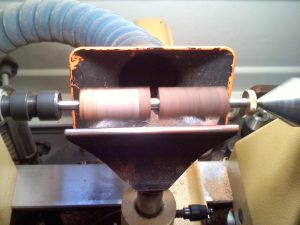
A lathe is one of the most versatile machine tools used in the manufacturing industry. It can cut, sand, drill, face, turn and deform workpieces. Lathes are characterized by the way in which they hold workpieces. While milling machines expose a stationary workpiece to a rotating cutting tool, lathes expose a rotating workpiece to a stationary cutting tool.
All lathes use this same method of operation: the workpiece is secured on the lathe, after which it rotates against a stationary cutting tool. Lathes, however, are often classified as either “wood” or “metal.” So, what’s the difference between wood lathes and metal lathes?
What Is a Wood Lathe?
A wood lathe is a type of lathe that’s designed specifically for woodworking applications. In other words, they are used to cut, sand, drill, face, turn and deform wooden workpieces. They still work like all other lathes by exposing a rotating workpiece to a stationary cutting tool. But wood lathes are used specifically to work wooden workpieces. They are not suitable for workpieces made of harder materials, including metal.
Wood lathes are smaller and simpler than their metal counterparts. The speed at which they rotate workpieces is controlled by a basic pulley system. They don’t produce as much power as metal lathes, but wood lathes are highly effective at manipulating wooden workpieces.
What Is a Metal Lathe?
A metal lathe, on the other hand, is a type of lathe that’s capable of performing metalworking applications. Because metal workpieces are harder than wooden workpieces, metal lathes are extremely powerful. They are able to aggressively manipulate and deform workpieces made of steel, iron, aluminum and other common metals.
Also known as a metalworking lathe, it’s a powerful machine that’s frequently used in manufacturing applications involving metal workpieces. Metal lathes are used in conjunction with a hardened cutting tool that’s secured to a rotating mounting surface. The metal workpiece is stationed on the lathe, after which the hardened cutting tool presses against it.
It’s important to note that metal lathes can still be used with wooden workpieces. Wood lathes only support wooden workpieces, but metal lathes support both wooden and metal workpieces.
In Conclusion
The difference between wood lathes and metal lathes is that the former is designed for wooden workpieces, whereas the latter supports both metal and wooden workpieces. Aside from their respective applications, wood lathes are smaller and simpler than metal lathes. Because of this, they tend to cost less as well.
